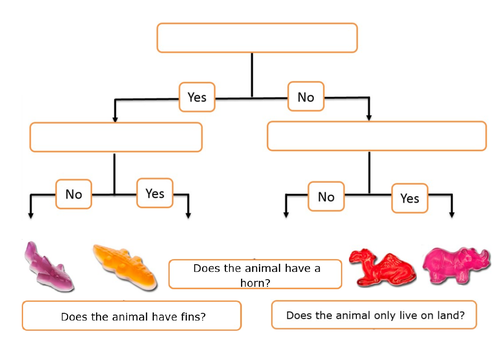









In lesson five pupils should be taught to:
- Re-cap ways to compare and contrast vertebrate groups
- Explore possible ways of grouping animals by making simple keys
The following summary is based on notes and guidance from the National Curriculum.
The pupils will be classifying living things and presenting data in a variety of ways to help in answering questions, discussing their findings with peers and the staff. The teaching activity ‘tabletennis’ could be used to allow students to discuss scientific terminology before comparing and contrasting using the Venn diagram. The students decide on two animals or are given two pictures of animals, they then state a key word / feature of the animal in turns until one person can’t go. The person who spoke last gains a point or wins the table tennis rally.
The pupils have the opportunity to group and classifying living things, carrying out simple comparisons using Haribo Phantasia sweets or the pictures provided. The students can then use the sweets to complete the Venn diagrams and recap their knowledge from the previous lesssons. Covering the same material more than once but in a slightly different way, will enhance learning / retention and is based on work by Ebbinghaus on learning curves. The students can also be given the chance to work independently by finding out more facts using secondary sources of information. In this lesson students were given the Haribo Phantasia sweets and allowed time to group the sweets into different categories based on the knowledge gained in the previous lessons.
The sweet sort activity, identifying different animals features and adaptations can be used as a stimulus to talk about criteria for grouping, sorting and classifying. They should begin to look for naturally occurring patterns and relationships between plants that share similar features.
Pupils should explore possible ways of grouping a wide selection of living things that include animals. The students can use their work from Venn diagrams and classification keys. They have been designed to allow pupils to identify differences between plant groups easily and the activities should flow, the differences between plant groups written in the Venn diagrams can be used in the boxes of the ‘yes’ / ‘no’ identification keys. The Venn diagrams are a resource to assess the pupils knowledge and for them to record the similarities and differences between different plant groups. The activities have been specifically designed to provide the scaffolding needed for pupils to put plants into groups
Pupils are given scientific words to read and opportunities to spell scientific vocabulary correctly to build their confidence and to use their growing spelling knowledge in a scientific context. The word list, phonetic sounds and definitions have been provided which could be used during their weekly spelling test.
The students will record their findings using simple scientific language and by completing keys and tables.
Something went wrong, please try again later.
This resource hasn't been reviewed yet
To ensure quality for our reviews, only customers who have purchased this resource can review it
Report this resourceto let us know if it violates our terms and conditions.
Our customer service team will review your report and will be in touch.